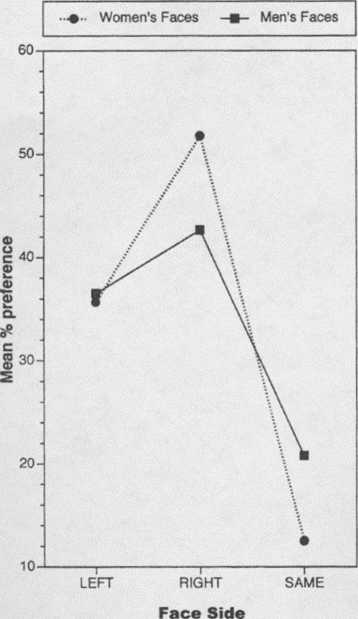228 RElS AND ZAIDEL
variables in the ANOVA were Face Sex (women, men) and Face Side (left-left,
right-right, same). A significant main effect for face side emerged,
F(2,46) = 32.39, p <.00001, reflecting a lower mean for left-left than for
right-right. The main effect for Face Sex was not significant, F(l, 23) = 4.02, p
<.06. The two-way interaction, Face Sex × Face Side, was significant,
F(2,46) = 4.76,p<.01. Figure 1 shows the nature of this interaction.
In view of the significant interaction, analyses for simple effects were applied
to the data. A significant difference between left-left and right-right emerged
only for women’s faces, (t= —2.95; d.f. = 23; p=.007), with a nonsignificant
difference for men’s faces (f= — 1.79; d.f. = 23; p = 0.09). The mean forjudging
both faces “same” was low by comparison, in both women’s and men’s faces
(see Figure 1).

Figure 1. The mean percent preference for left-left, right-right, or same (i.e.. no difference) by
subjects viewing pairs of faces and deciding which one looks healthier.
More intriguing information
1. Gender stereotyping and wage discrimination among Italian graduates2. Credit Markets and the Propagation of Monetary Policy Shocks
3. 101 Proposals to reform the Stability and Growth Pact. Why so many? A Survey
4. Output Effects of Agri-environmental Programs of the EU
5. Human Development and Regional Disparities in Iran:A Policy Model
6. Transport system as an element of sustainable economic growth in the tourist region
7. Migrating Football Players, Transfer Fees and Migration Controls
8. A Critical Examination of the Beliefs about Learning a Foreign Language at Primary School
9. The name is absent
10. Public-Private Partnerships in Urban Development in the United States